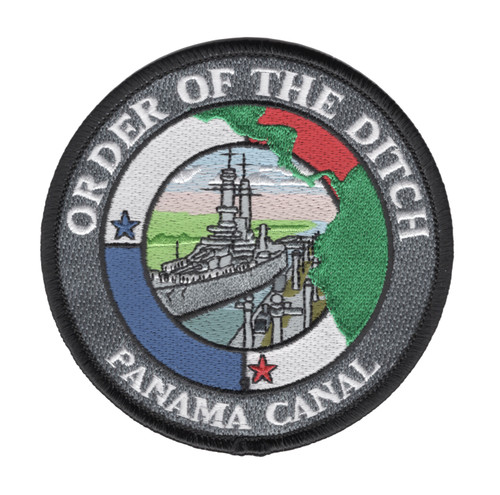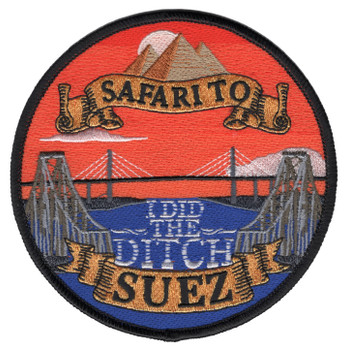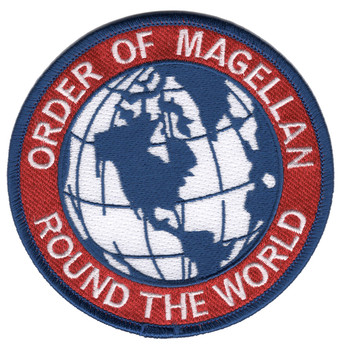Description
Order Of The Ditch Panama Canal Patch (U.S. Navy) 4.0" x 4.0" Embroidered Patch with Iron-On Backing
Superior Materials: Made with premium polyester thread and durable twill fabric, ensuring long-lasting color and strength.
Advanced Embroidery Technology: Crafted using the most advanced embroidery machinery, guaranteeing intricate detail, sharp lines, and consistent quality every time.
Easy Iron-On Application: Features a heat-activated adhesive backing for quick, no-sew attachment. Simply position, iron, and press for a secure bond.
Versatile Use: Perfect for personalizing jackets, backpacks, uniforms, or any fabric surface that needs a touch of personality.
Durable and Washable: Designed to withstand everyday wear and occasional washing without fading or fraying.
Formations & Origins
The "Order of the Ditch" Panama Canal patch is a symbol of a unique and prestigious distinction awarded to those who have successfully completed the passage through the Panama Canal aboard a U.S. Navy ship. The "Ditch" refers to the Panama Canal itself, which has served as a vital waterway connecting the Atlantic and Pacific Oceans, and the order was created to honor sailors and officers who sailed through this remarkable engineering marvel. The Panama Canal, opened in 1914, dramatically reduced travel time for ships navigating between the two oceans, and its importance to global trade and military operations has remained indispensable ever since.
The "Order of the Ditch" is not an official U.S. Navy award or decoration but a humorous, informal tradition among naval personnel. The order celebrates the completion of the canal transit, with the ceremony typically involving a lighthearted, ceremonial induction for sailors who have crossed the isthmus. The tradition includes specific rites of passage, such as the "initiation" process where first-time transiting sailors are often subject to playful rituals and recognition by their peers.
Over the years, this tradition has persisted as a mark of honor and camaraderie, celebrating those who have sailed through one of the most famous and significant waterways in the world. It is a badge of honor worn with pride by many who serve in the U.S. Navy, particularly those who have navigated through the Panama Canal during deployments, exercises, or transports.
Notable Commanders
The "Order of the Ditch" Panama Canal patch does not have a specific commander associated with it, as it is more of a sailors' tradition than an official command. However, several naval leaders and officers have overseen operations involving the Panama Canal, and their leadership has helped maintain the vital importance of this route for military and commercial purposes.
One notable figure in the history of the Panama Canal is Admiral William D. Leahy, who served as the first Chief of Naval Operations (CNO) under President Franklin D. Roosevelt. During World War II, the Panama Canal was crucial in facilitating the movement of naval vessels between the Atlantic and Pacific Oceans. Leahy's leadership ensured that the canal remained operational and secure, contributing to its role in the U.S. Navy’s strategy for victory in the Pacific.
Additionally, Admiral Hyman Rickover, often referred to as the "Father of the Nuclear Navy," played a pivotal role in ensuring that nuclear submarines and vessels would be able to transit the Panama Canal, solidifying its importance in the Cold War era. Though these leaders were not directly involved in the "Order of the Ditch" tradition, their leadership helped shape the operational history of the canal in military terms.
Major Campaigns/Operations
The Panama Canal has played a critical role in various military operations, particularly in the 20th century, when its strategic importance became even more pronounced. One of the most notable instances was during World War II. As the war raged across both the Atlantic and Pacific Oceans, the canal served as a vital transportation link for U.S. naval vessels moving between the theaters of war. The Panama Canal Zone, a U.S. territory at the time, was heavily fortified to prevent any potential enemy from blocking or attacking this crucial waterway.
In the Cold War era, the Panama Canal continued to be integral to military operations, particularly with the advent of nuclear submarines, which could transit the canal en route to various locations around the world. The canal enabled the rapid movement of naval vessels, including aircraft carriers, destroyers, and supply ships, enhancing the ability of the U.S. Navy to project power globally.
The canal also played a role in various naval operations, such as Operation Just Cause in 1989, where U.S. forces used the canal to move troops and equipment into Panama for the purpose of deposing dictator Manuel Noriega and restoring democracy. This operation highlighted the continued strategic relevance of the Panama Canal in modern military campaigns.
Specialized Role/Equipment
The Panama Canal has specialized equipment designed to facilitate the smooth and safe passage of ships, including large vessels like aircraft carriers and cargo ships, that transit its waters. The system of locks, which raises and lowers ships to account for the difference in elevation between the Atlantic and Pacific Oceans, is a marvel of engineering. Naval ships, especially larger ones, require specific accommodations to pass through the canal’s narrow and highly regulated channels.
For U.S. Navy vessels, the canal serves as a key transit point during deployments, maneuvers, and strategic operations. As such, naval crews must be familiar with the procedures for navigating through the canal safely. Special units within the Navy, particularly the Naval Construction Battalions (Seabees), have been involved in maintaining the infrastructure of the canal and assisting with any military operations related to it.
The patch itself serves as a symbol of sailors' knowledge of the canal’s importance and their accomplishment in navigating through this historic waterway. It is often seen as an informal but deeply cherished badge of experience and accomplishment among those who have crossed the isthmus.
Acts of Heroism
While the "Order of the Ditch" Panama Canal patch is not directly tied to acts of heroism in the traditional sense, there are stories of heroism associated with the canal and the U.S. Navy’s role in maintaining its safety and operational integrity. For example, during World War II, the canal was a vital target for the Japanese Empire, and U.S. naval forces stationed in the Panama Canal Zone played a critical role in ensuring its security against potential attacks.
In more modern times, during operations such as Operation Just Cause, U.S. naval forces were required to act decisively and with precision when using the canal to move troops and supplies into Panama. In this instance, many service members, including naval personnel, demonstrated bravery and professionalism as they secured the waterway and supported operations on the ground. The passage through the canal itself was a small but significant part of a much larger military effort to restore democracy and stabilize the region.
While the "Order of the Ditch" patch is more of a ceremonial recognition than a marker of heroism, the naval personnel who have passed through the canal as part of critical military operations have, in their own right, contributed to acts of valor in defense of U.S. interests.
Legacy & Notable Achievements
The legacy of the "Order of the Ditch" Panama Canal patch is tied directly to the history of the canal itself and the sailors who have navigated it. The patch represents a milestone in the careers of naval personnel, marking a successful passage through one of the most significant man-made waterways in the world. It is a unique tradition, fostering camaraderie among sailors and celebrating a shared experience that marks their connection to a broader history of naval service and U.S. military operations.
The Panama Canal’s legacy extends beyond the U.S. Navy and is intertwined with the broader legacy of global trade and military strategy. The canal has enabled faster and more efficient movement of goods and military resources, which in turn has shaped U.S. military power projection and logistics operations. It also remains a symbol of American ingenuity and international cooperation, as it continues to serve as a vital shipping route.
While the Panama Canal Zone is no longer a U.S. territory following the transfer of control to Panama in 1999, the strategic and symbolic significance of the canal has not diminished. The sailors who have earned the "Order of the Ditch" Panama Canal patch are part of this enduring legacy, having contributed to the canal’s operational history through their service.
In the end, the "Order of the Ditch" patch is a token of respect for the naval personnel who have passed through the Panama Canal, honoring their connection to one of the world’s most important and enduring waterways, as well as the camaraderie and history they share as part of the U.S. Navy’s long tradition of service.







